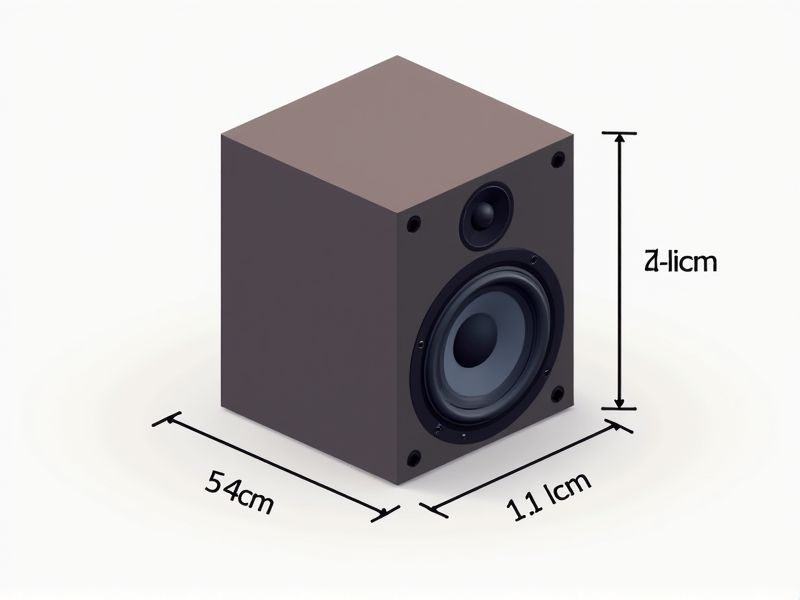
When designing a speaker box, standard dimensions vary based on the type and size of the speaker driver, but some general guidelines can help. For example, a common size for a bookshelf speaker box for a 6.5-inch woofer is about 16 inches high, 9 inches wide, and 12 inches deep. It's important to ensure the internal volume matches the manufacturer's recommendations for your specific driver, as this affects sound quality and performance. For best results, always refer to your speaker's datasheet to calculate the ideal box volume and dimensions for your application.
Internal Volume
The internal volume of a speaker box significantly affects sound quality and performance, with most high-quality designs ranging between 0.5 to 2 cubic feet. This volume allows for optimal airflow and resonance, enhancing bass response and overall clarity. A well-calibrated speaker box minimizes distortion, making the listening experience more enjoyable, especially in genres requiring deep bass. For you, choosing a box with the right internal volume tailored to your speaker specifications can greatly improve audio fidelity.
Aspect Ratio
The aspect ratio of a speaker box significantly influences sound quality and performance; a common ideal is 1:1.414, which is the golden ratio. This ratio helps minimize distortion while maximizing the speaker's efficiency in producing a dynamic range of frequencies. When designing or selecting a speaker box, consider that variations in aspect ratio can impact resonance and bass response, with larger boxes generally enhancing low frequencies. Ensuring your speaker box adheres to an optimal aspect ratio can enhance your audio experience by delivering clearer and more balanced sound.
Baffle Width
Baffle width plays a crucial role in the acoustic performance of a speaker box, significantly influencing sound dispersion and resonance. A wider baffle typically provides better low-frequency response, creating a fuller sound, while a narrower baffle can enhance higher frequencies, giving a more defined audio output. For optimal sound reproduction, many audiophiles recommend a baffle width of approximately 12-15 inches for floor-standing speakers. Understanding the impact of baffle width can help you achieve the ideal listening experience in your audio setup.
Panel Thickness
The optimal panel thickness for speaker boxes typically ranges from 3/4 inch to 1 inch, ensuring structural integrity and minimizing unwanted vibrations. A thickness of 3/4 inch is widely used in medium-sized speakers, providing a good balance between weight and acoustic performance. For larger, high-powered systems, a 1-inch thick panel is often preferred to enhance durability and sound quality. Consider your specific speaker design, as the right panel thickness can significantly affect both sound clarity and overall longevity of the speaker box.
Port Diameter
The port diameter of a speaker box significantly influences its acoustic performance, impacting both sound quality and bass response. For optimal bass reproduction, a port diameter of 4 inches is generally recommended for small to medium-sized speakers, while larger models can benefit from diameters of 6 inches or more. The tuning frequency, directly affected by the port's size, is crucial in determining how well the speaker can handle low frequencies. Ensuring the correct port diameter can enhance your audio experience, providing clearer sound production and greater depth in music playback.
Tuning Frequency
The tuning frequency of a speaker box significantly influences sound quality and performance, often measured in Hertz (Hz). For optimal bass response, a tuning frequency between 30 Hz to 50 Hz is commonly recommended. This ensures that lower frequencies resonate effectively, creating a rich audio experience while minimizing distortion. To achieve your desired sound profile, carefully consider the enclosure volume and port dimensions, as these factors directly correlate with the box's tuning frequency.
Driver Displacement
Driver displacement, measured in cubic centimeters (cc), is a critical factor influencing the performance of speaker boxes. A larger driver displacement typically allows for more air movement, resulting in deeper bass response and improved sound quality. For instance, speakers with driver displacements exceeding 20 cc often produce clearer low-frequency sounds, enhancing your audio experience. Understanding the relationship between driver displacement and overall speaker efficiency can significantly impact your choice of audio equipment.
Bracing Requirements
Bracing requirements play a crucial role in the structural integrity and acoustic performance of speaker boxes. Properly designed bracing minimizes resonance, ensuring clearer sound production and reducing distortion. For optimal results, use internal bracing that is strategically spaced, typically every 12 to 18 inches, depending on the size of the enclosure. Implementing these standards can significantly enhance your speaker's overall audio experience while prolonging its lifespan.
Vent Area
The vent area of a speaker box is crucial for optimal sound quality, directly affecting bass response and overall performance. A larger vent area can improve airflow, allowing for greater volume and lower frequency output. For instance, tuning the vent to a specific frequency can enhance sound clarity by minimizing distortion. When designing your speaker box, consider that a vent area approximately 10% of the box volume often yields the best results in acoustic performance.
Faceplate Cutout Size
The faceplate cutout size for speaker boxes is critical for optimal sound performance and aesthetic integration into your audio system. Typically, this cutout size ranges from 6.5 inches to 15 inches in diameter, depending on the speaker type and design. A precise fit ensures that there are no air leaks, which can negatively impact sound quality by causing distortion or reduced bass response. When selecting or creating a speaker box, be sure to measure accurately; the right faceplate cutout size enhances both the appearance and functionality of your audio setup.
